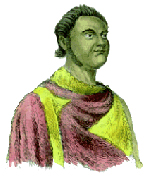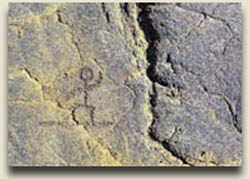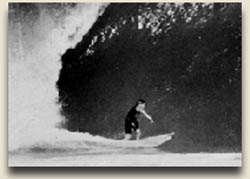The History
of Surfing
by Les Drent
From
the Journal of Captain King, Cook's Voyages, March 1779, three months
after the death of Captain Cook: "The surf, which breaks on the coast round the bay, extends to the
distance of about one hundred fifty yards from the shore, within which
space, the surges of the sea, accumulating from the shallowness of the
water, are dashed against the beach with prodigious violence. Whenever,
from stormy weather, or any extraordinary swell at sea, the impetuosity
of the surf is increased to its utmost heights, they choose that time
for this amusement: twenty or thirty of the natives, taking each a long
narrow board, rounded at the ends, set out together from the shore. The
first wave they meet, they plunge under, and suffering it to roll over
them, rise again beyond it, and make the best of their way, by swimming,
out into the sea. The second wave is encountered in the same manner with
the first; the great difficulty consisting in seizing the proper moment
of diving under it, which, if missed, the person is caught by the surf,
and driven back again with great violence; and all his dexterity is then
required to prevent himself from being dashed against the rocks. As soon
as they have gained, by these repeated efforts, the smooth water beyond
the surf, they lay themselves at length on their board, and prepare for
their return. As the surf consists of a number of waves, of which every
third is remarked to be always much larger than the others, and to flow
higher on the shore, the rest breaking in the intermediate space, their
first object is to place themselves on the summit of the largest surge,
by which they are driven along with amazing rapidity toward the shore.
If by mistake they should place themselves on one of the smaller waves,
which breaks before they reach the land, or should not be able to keep
their plank in a proper direction on the top of the swell, they are left
exposed to the fury of the next, and, to avoid it, are obliged again to
dive, and regain the place from which they set out. Those who succeed in
their object of reaching the shore, have still the greatest danger to
encounter. The coast being guarded by a chain of rocks, with, here and
there, a small opening between them, they are obliged to steer their
board through one of these, or, in case of failure, to quit it, before
they reach the rocks, and, plunging under the wave, make the best of
their way back again. This is reckoned very disgraceful, and is also
attended with the loss of the board, which I have often seen, with great
terror, dashed to pieces, at the very moment the islander quitted it.
The boldness and address, with which we saw them perform these difficult
and dangerous manoeuvres, was altogether astonishing, and is scarcely to
be credited." "The surf, which breaks on the coast round the bay, extends to the
distance of about one hundred fifty yards from the shore, within which
space, the surges of the sea, accumulating from the shallowness of the
water, are dashed against the beach with prodigious violence. Whenever,
from stormy weather, or any extraordinary swell at sea, the impetuosity
of the surf is increased to its utmost heights, they choose that time
for this amusement: twenty or thirty of the natives, taking each a long
narrow board, rounded at the ends, set out together from the shore. The
first wave they meet, they plunge under, and suffering it to roll over
them, rise again beyond it, and make the best of their way, by swimming,
out into the sea. The second wave is encountered in the same manner with
the first; the great difficulty consisting in seizing the proper moment
of diving under it, which, if missed, the person is caught by the surf,
and driven back again with great violence; and all his dexterity is then
required to prevent himself from being dashed against the rocks. As soon
as they have gained, by these repeated efforts, the smooth water beyond
the surf, they lay themselves at length on their board, and prepare for
their return. As the surf consists of a number of waves, of which every
third is remarked to be always much larger than the others, and to flow
higher on the shore, the rest breaking in the intermediate space, their
first object is to place themselves on the summit of the largest surge,
by which they are driven along with amazing rapidity toward the shore.
If by mistake they should place themselves on one of the smaller waves,
which breaks before they reach the land, or should not be able to keep
their plank in a proper direction on the top of the swell, they are left
exposed to the fury of the next, and, to avoid it, are obliged again to
dive, and regain the place from which they set out. Those who succeed in
their object of reaching the shore, have still the greatest danger to
encounter. The coast being guarded by a chain of rocks, with, here and
there, a small opening between them, they are obliged to steer their
board through one of these, or, in case of failure, to quit it, before
they reach the rocks, and, plunging under the wave, make the best of
their way back again. This is reckoned very disgraceful, and is also
attended with the loss of the board, which I have often seen, with great
terror, dashed to pieces, at the very moment the islander quitted it.
The boldness and address, with which we saw them perform these difficult
and dangerous manoeuvres, was altogether astonishing, and is scarcely to
be credited." Captain King's journal entry is the first description of he'e nalu, the Hawaiian word for surfing, ever recorded by Western man. Since there was no written language at this time in Hawaii, King's journal entry serves as man's earliest written account of this Hawaiian sport. Not only is the passage humorous, it also portrays how foreign something like surfing must have appeared at first sight to King and his men, especially when most European sailors of the day could not swim. Other travelers from the West who followed Captain Cook's arrival to Hawaii had a difficult time comprehending what the Hawaiians were actually doing in the surf. Early print-block engravings that began appearing back in Europe show an often skewed perception of the sport.  The
ancient Hawaiians, however, left us more accurate evidence of their
sport. Petroglyphs of surfers, carved into the lava-rock landscape, and
chants that tell the stories of great surfing feats, carried a symbolic
lore throughout the generations. Some of these chants date as far back
as 1500 A.D., which leads us to believe that surfing may have begun long
before this time in the Polynesian culture. What we do know about the
origin of surfing in Hawaii is that it was part of the Kapu system of
laws, which held Hawaiian royalty above the commoners in the kingdom.
Chiefs used surfing and other Hawaiian sports as competition to maintain
their strength, agility and command over their people. The
ancient Hawaiians, however, left us more accurate evidence of their
sport. Petroglyphs of surfers, carved into the lava-rock landscape, and
chants that tell the stories of great surfing feats, carried a symbolic
lore throughout the generations. Some of these chants date as far back
as 1500 A.D., which leads us to believe that surfing may have begun long
before this time in the Polynesian culture. What we do know about the
origin of surfing in Hawaii is that it was part of the Kapu system of
laws, which held Hawaiian royalty above the commoners in the kingdom.
Chiefs used surfing and other Hawaiian sports as competition to maintain
their strength, agility and command over their people.The Kapu system also determined how, why and with what materials surfboards were to be made. The type of wood used in making a board depended on the future rider's status in society. Class distinction in old Hawaii was as apparent in the ownership of surfboards as it was in all other aspects of the culture. If shaping the board for the alii or ruling class, a lengthy surfboard between 14 and 16 feet long was superiorly crafted using premium wood. Hawaiians often made this larger board, called an olo, with the light and more buoyant wood from the wiliwili tree. Because of their size, these boards could weigh up to 175 pounds. The other board, called an alai, was normally intended for the commoners and was made smaller, 10 to 12 feet, with a heavier and denser wood, koa. After the craftsmen selected the wood to be used, they prayed and placed a ceremonial fish, kumu, in a hole near the tree's roots. Only after this ritual was completed could the tree be cut down. They then hauled the tree away and chipped and shaped it to size with a bone or stone adze. When they achieved the general shape and size of the board, they took it to the halau, or canoe house, near the beach for the finishing touches. With pohaku puna (granulated coral) or oahi (rough stone), craftsmen would remove the adze marks on the board's surface. After the board had been sufficiently planed, they applied a black finish to its surface with the root of the ti plant, hili (pounded bark) or the stain from banana buds. Sometimes they acquired the dark stain by rubbing the soot from burned kukui nuts into the wood. Once this black stain had dried, the board's surface was treated with kukui oil, giving it a glossy finish. When the surfboard was finished, its creators dedicated it before its first voyage into the sea. After each use, it was habitually treated with coconut oil and wrapped in tapa cloth to preserve and protect the wood. Through all this laboring detail, the surfboard became a valuable and revered part of Hawaiian culture. Surfing rituals and the sport itself continued in the Kapu system until missionaries from New England began arriving in 1820. The missionaries believed surfing and other Hawaiian sports to be hedonistic acts and a waste of time. They adamantly preached against the sports' existence in Hawaii. By 1890, surfing in Hawaii was nearly extinct, with the sport practiced in only a few places. The rapidly growing agricultural empire coming into place, coupled with the immigration of foreigners, also contributed to the decline of surfing, along with many other sacred aspects of the Polynesian culture. If not for the dedication of a few Hawaiian kings like David Kalakau, an advocate of all Hawaiian sports, surfing may not have survived to see the 20th century. In 1905, a teenager named Duke Kahanamoku and his friends began to gather under a hau (lowland) tree at Waikiki beach. Duke and his friends, who spent their days surfing, later created their own surfing club, Hui Nalu, or "The Club of the Waves." By this time, the missionaries' influence over the island had begun to decline, freeing up an avenue for the reintroduction of surfing in Hawaii. Duke and his friends later became known as the famous "Beach Boys of Waikiki" and are credited with the rebirth of surfing in Hawaii. Another individual who played an important part in the revitalization of surfing in Hawaii was also the first to bring the sport to California. In 1907, California land developer Henry Huntington asked Irish Hawaiian George Freeth to give a surfing demonstration at the opening of the Redondo-Los Angeles railroad at Redondo beach. Freeth was also the first person to create a shorter surfboard by cutting the large 16-foot design in half. His introduction of surfing to the spectators on the beaches of California ignited a revolution in both surfboard design and wave-riding techniques. The California shores soon became grounds for surfing expansion and innovation. Over the following years, the freedom to experiment in size, weight and shape, along with the introduction of fins and styrofoam, became popular topics for surfers looking to equip themselves for the larger and more challenging surf in places such as the perilous North Shore of Oahu during the winter months. The gentle waves found at Waikiki beach were perfect for the promotion of surfing, but it was the lure of giant waves that prompted the real dares for surfers looking to put it all on the line.  By
1955, the attraction of the North Shore's swells had brought on a
migration of surfers from California in search of the ultimate ride down
some of the world's biggest waves. Perhaps the most famous of these big
wave breaks can be found at Oahu's Walmea Bay. When the winter swells
hit at Waimea it is not uncommon to see waves climb to nearly 25 feet in
height. Surfer Greg Ambrose, in his book Surfer's Guide to Hawaii,
writes this about Waimea: "When surfing Waimea it is essential to have
the proper crazed attitude that implies a certain reckless disregard for
personal safety. If you paddle out thinking you are going to get hurt,
you will. If you think you can't make the drop, you won't. If you begin
to wonder what in the world you're doing out among those menacing waves,
it's time to be thankful you're still alive and head for the beach." It
was this kind of thrill seeking and addiction to big wave riding that
revolutionized the sport of surfing. By
1955, the attraction of the North Shore's swells had brought on a
migration of surfers from California in search of the ultimate ride down
some of the world's biggest waves. Perhaps the most famous of these big
wave breaks can be found at Oahu's Walmea Bay. When the winter swells
hit at Waimea it is not uncommon to see waves climb to nearly 25 feet in
height. Surfer Greg Ambrose, in his book Surfer's Guide to Hawaii,
writes this about Waimea: "When surfing Waimea it is essential to have
the proper crazed attitude that implies a certain reckless disregard for
personal safety. If you paddle out thinking you are going to get hurt,
you will. If you think you can't make the drop, you won't. If you begin
to wonder what in the world you're doing out among those menacing waves,
it's time to be thankful you're still alive and head for the beach." It
was this kind of thrill seeking and addiction to big wave riding that
revolutionized the sport of surfing. |
||
|
|
|
|
|
|
||
| History | Atlas | Culture | Language | Links |